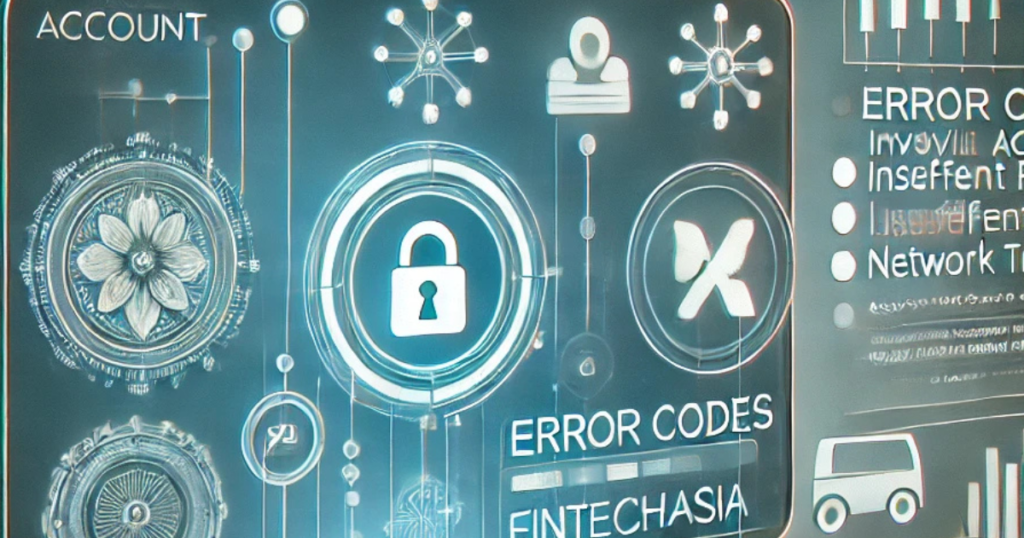In the fast-evolving world of financial technology, efficiency and reliability are critical. However, even the most advanced platforms can encounter issues. Error Codes FintechAsia services serve as diagnostic tools, helping users and developers identify problems and take corrective actions. This article provides an in-depth look at the Top 10 error codes in FintechAsia, their causes, and how to resolve them effectively.
Introduction to FintechAsia Error Codes
What Are FintechAsia Error Codes?
Error codes are predefined messages generated by a system when something goes wrong. In FintechAsia, these codes provide insights into transaction issues, account errors, or system failures. By understanding them, users and developers can troubleshoot problems efficiently, ensuring smoother operations.
Why Are Error Codes Important?
Error codes act as a bridge between users and the system, simplifying complex technical issues into actionable insights. They help users identify problems quickly, reduce downtime, and maintain trust in FintechAsia services.
How to Identify FintechAsia Error Codes
Reading and Understanding Error Messages
Error messages often include a code and brief description, such as “Error 100: Invalid Account Number.” Understanding this information is the first step in resolving the issue.
Diagnostic Tools for Error Identification
FintechAsia platforms often provide built-in diagnostic tools or customer support services to help users decode error messages. External resources, like forums and knowledge bases, can also be invaluable.
Common Causes of Error Codes in FintechAsia
1. Technical Glitches
System outages, server downtime, or connectivity issues are common technical problems leading to error codes.
2. User Errors
Simple mistakes, such as entering incorrect account details or passwords, can trigger errors.
3. Security Protocols
Strict security measures, such as fraud detection systems, may flag transactions unnecessarily, generating error codes.
Top 10 Error Codes in FintechAsia and Their Resolutions
1. Error Code 100: Invalid Account Number
Cause:
This error occurs when the account number provided is incorrect or doesn’t exist in the system.
Resolution:
Double-check the account details before resubmitting. Ensure that no digits are missing or transposed.
2. Error Code 200: Insufficient Funds
Cause:
Triggered when the transaction amount exceeds the account balance.
Resolution:
Deposit additional funds into the account or reduce the transaction amount to match the available balance.
3. Error Code 300: Network Timeout
Cause:
Occurs due to slow or interrupted internet connections during a transaction.
Resolution:
Retry the transaction in a stable network environment. If the issue persists, check the status of the FintechAsia platform for potential outages.
4. Error Code 400: Invalid OTP (One-Time Password)
Cause:
Generated when an expired or incorrect OTP is entered.
Resolution:
Request a new OTP and ensure timely entry. Avoid using autofill if it inputs outdated data.
5. Error Code 500: Transaction Declined by Bank
Cause:
The bank flags the transaction for reasons such as unusual activity or insufficient permissions.
Resolution:
Contact your bank for clarification. Ensure your account settings allow the type of transaction being attempted.
6. Error Code 600: Unauthorized Access
Cause:
Triggered when logging in from unrecognized devices or locations.
Resolution:
Verify your identity through multi-factor authentication. Update security settings to avoid future access issues.
7. Error Code 700: Payment Gateway Failure
Cause:
Occurs when the third-party payment processor experiences technical difficulties.
Resolution:
Wait until the gateway issues are resolved, or use an alternative payment method.
8. Error Code 800: Duplicate Transaction
Cause:
Triggered when the same transaction is repeated unintentionally.
Resolution:
Review your transaction history to confirm if the payment was processed before retrying.
9. Error Code 900: Currency Mismatch
Cause:
Occurs when attempting transactions in unsupported currencies.
Resolution:
Ensure the transaction is made in the correct currency or enable multi-currency options in your account.
10. Error Code 1000: Suspicious Activity Detected
Cause:
The system flags transactions as potentially fraudulent based on certain patterns.
Resolution:
Contact FintechAsia customer support to verify your identity and unlock your account.
Also Read: Lovelolablog Guide
Proactive Measures to Avoid Error Codes in FintechAsia
1. Best Practices for Users
- Keep account information updated and accurate.
- Use strong passwords and enable multi-factor authentication.
- Regularly monitor your transaction history.
2. Developer-Level Solutions
- Implement robust error-handling systems.
- Conduct regular system maintenance to minimize glitches.
- Ensure real-time updates to security protocols.
Benefits of Resolving Error Codes Quickly
- Enhanced User Experience: Resolving issues promptly ensures uninterrupted transactions.
- Trust and Credibility: Efficient error handling fosters trust in FintechAsia services.
Real-Life Examples of Error Code Resolutions
Consider a user encountering Error Code 300 during a high-value transaction. By following the platform’s network stability tips, they successfully completed the payment without further delays. Stories like this highlight the importance of understanding and resolving error codes efficiently.
Future Trends in Fintech Error Management
- AI and Automation: Using machine learning to predict and prevent errors.
- Seamless Integrations: Reducing dependency on third-party gateways to minimize issues like Error Code 700.
Conclusion
Understanding and resolving Error Codes FintechAsia is crucial for maintaining a seamless user experience. By identifying the top 10 error codes and their solutions, users can handle issues confidently while developers focus on improving system reliability. Start implementing these solutions today for a hassle-free financial journey.
Call-to-Action
Share your experiences with FintechAsia error codes in the comments, and don’t forget to explore our platform’s support tools for further assistance!

